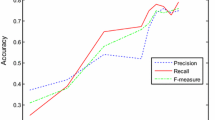Abstract
The product comments in e-commerce circumstance has a strong guidance role on customers, therefore the merchants will usually falsify bogus comments to defraud customers. In order to monitor such behaviors of merchants, we transform the comments of the same product from different merchants to eigenvector by the way of affective computing, then compare it with the vector derived from the comments on the third-party professional assessment and test websites as well as on the microblog, and identify those vectors with big deviation degree, that means the product of those merchants are possibly in fraudulence. Experiment proves that the system can recognize fraudulent merchants.


Similar content being viewed by others
References
Cen, W. (2009). The impacts of factors of merchants on the consumer behaviors in C2C. Modern Business Trade Industry, 21(22), 112–114.
Kumar, R., Yan, Z., & Zhang, J. (2005). Virtualization for manufacturing web services: A WS-RF approach. International Journal of Information Technology, 11(3), 40–51.
Inthiran, A., Alhashmi, S. M., & Ahmed, P. K. (2010). A reflection of current search engine techniques on medical search environments. In Intelligent Environments (IE), Sixth International Conference on, IEEE (pp. 170–173).
Strader, T. J., & Ramaswami, S. N. (2002). The value of seller trustworthiness in C2C online markets. Communications of the ACM, 45(12), 45–49.
Yamamoto, H., Ishida, K., & Ohta, T. (2004). Modeling reputation management system on online C2C market. Computational & Mathematical Organization Theory, 10(2), 165–178.
Piao, C., An, J., & Fang, M. (2007). Study on credit evaluation model and algorithm for C2C e-commerce. In E-Business Engineering, ICEBE2007, IEEE International Conference on 2007, IEEE (pp. 392–395).
Wang, Y., & Lim, E. P. (2008). The evaluation of situational transaction trust in e-service environments. In E-business Engineering, 2008, ICEBE’08. IEEE International Conference on, IEEE (pp. 265–272).
Chen, X., Liu, Y., & Sun, H. (2008). AHP-based multi-dimension credit evaluation model for e-commerce. In E-Business Engineering, 2008, ICEBE’08, IEEE International Conference on, IEEE (pp. 273–278).
Haojin, J., & Li, J. (2007). Researches on web-service encapsulation of networked manufacturing resources: Based on WSRF. Computer Engineering and Applications, 43(15), 22–25.
Zhen, P. R., Miao, D. Q., & Zhang, Z. F. (2012). A detection method of Chinese microblog news topic. Computer Science, 39(1), 138–141.
Hu, M., & Liu, B. (2004). Mining opinion features in customer reviews. AAAI, 4, 755–760.
Kobayashi, N., Inui, K., & Matsumoto, Y. (2005). Collecting evaluative expressions for opinion extraction. In K.-Y. Su, J. Tsujii, J.-H. Lee, O. Y. Kwong (Eds.), Natural Language Processing-IJCNLP 2004 (Vol. 3248, pp. 596–605). Heidelberg: Springer.
Lishi, Y. Q. & Li, Y. J. (2010). Mining the chrematistics of products and affective tendencies of consumer comments on Chinese websites. Application Research of Computers, 27(8), 3016–3019.
Yu, J. Q., Zha, J. Z., & Lu, Y. (2010). Designing the distributed collaborative system for complex product. Journal of Central South University (Science and Technology), 41(2), 539–546.
Aggarwal, C. C., & Philip, S. Y. (2005). An effective and efficient algorithm for high dimensional outlier detection. The VLDB Journal, 14(2), 211–221.
Zhuang, L., Jing, F., & Zhu, X. Y. (2006). Movie review mining and summarization. In Proceedings of the 15th ACM International Conference on Information and Knowledge Management, ACM (pp. 43–50).
Yao, T. F., & Lou, D. C. (2007). Researches of the method of analyzing the theme semantic tendency of Chinese sentences. Journal of Chinese Information Procession, 21(5), 73–79.
Author information
Authors and Affiliations
Corresponding author
Rights and permissions
About this article
Cite this article
Huang, A. A risk detection system of e-commerce: researches based on soft information extracted by affective computing web texts. Electron Commer Res 18, 143–157 (2018). https://doi.org/10.1007/s10660-017-9262-y
Published:
Issue Date:
DOI: https://doi.org/10.1007/s10660-017-9262-y




